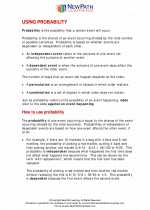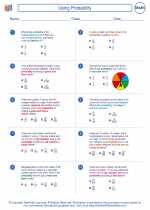Conditional Probability
Conditional probability is the probability of an event occurring given that another event has already occurred. It is denoted by P(A|B), which reads as "the probability of event A given event B."
Calculating Conditional Probability
The formula for calculating conditional probability is:
P(A|B) = P(A and B) / P(B)
Where P(A and B) is the probability of both events A and B occurring, and P(B) is the probability of event B occurring.
Example
Suppose you have a standard deck of 52 playing cards. What is the probability of drawing a king from the deck given that the card drawn is a heart?
Here, event A is drawing a king and event B is drawing a heart. We can calculate the conditional probability as follows:
P(A|B) = P(A and B) / P(B)
P(A and B) is the probability of drawing a king of hearts, which is 1/52, and P(B) is the probability of drawing a heart, which is 13/52. So,
P(A|B) = (1/52) / (13/52) = 1/13
So, the probability of drawing a king given that the card drawn is a heart is 1/13.
Study Guide
- Understand the concept of conditional probability and how it differs from regular probability.
- Learn the formula for calculating conditional probability and how to apply it to different scenarios.
- Practice calculating conditional probabilities using examples involving events with and without replacement.
- Understand the concept of independence and dependence of events in the context of conditional probability.
- Practice solving problems involving conditional probability in real-life scenarios, such as medical tests, weather forecasts, and game theory.
Summary
Conditional probability is the likelihood of an event occurring given that another event has already occurred. It is calculated using the formula P(A|B) = P(A and B) / P(B), and is used to make predictions and decisions in various fields including finance, healthcare, and engineering.
[Conditional Probability] Related Worksheets and Study Guides:
.◂Math Worksheets and Study Guides Seventh Grade. Using Probability

 Worksheet/Answer key
Worksheet/Answer key
 Worksheet/Answer key
Worksheet/Answer key
 Worksheet/Answer key
Worksheet/Answer key
